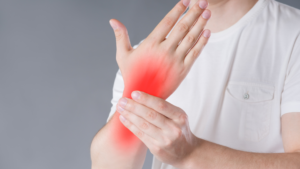What is Complex Regional Pain Syndrome
Complex regional pain syndrome (CRPS) is a chronic pain condition that typically affects a limb, like a leg or an arm. Damage or malfunction to the central nervous system is what is believed to cause complex regional pain syndrome. The central nervous system contains the brain and spinal cord. Things like injuries, surgeries, strokes, or heart attacks are common causes.

What is Complex Regional Pain Syndrome
This condition is not common. In fact, it is difficult to diagnose and is historically tricky to treat. The affected area is not only extremely painful but other symptoms can include a change of body temperature, discoloration, and swelling in the affected area.
CPRS can be divided into two types: CRPS-I and CRPS-II. CRPS-I is previously known as reflex sympathetic dystrophy (RSD) syndrome. This type is when patients do not have a confirmed nerve injury or disorder. CRPS-II (also known as causalgia) is when the condition stems from a confirmed nerve injury. Despite there being two types of CRPS, treatments are similar.
Symptoms of Complex Regional Pain Syndrome
The symptoms of CRPS vary. The main symptom that is present is long-term severe pain that may be constant. This pain is often described as burning or a pins-and-needles sensation. Symptoms may change over time, but pain, swelling, redness, and hypersensitivity (allodynia) are typically the first symptoms that occur. Pain has been known to spread, even if the affected area is only a hand or even finger. While this is rare, complex regional pain syndrome may spread to other extremities, such as the opposite limb or other area of the body.
Symptoms can go away on their own, overtime.
Other symptoms of CRPS include:
- Changes in hair growth patterns
- Joint stiffness
- Decreased muscle coordination
- Abnormal sweating pattern in the affected area
- Tremors or jerking of the affected limb
Diagnosis and Treatment Options
Diagnosis
CRPS is diagnosed based on a patient’s medical history and present symptoms. It is especially difficult to diagnose because the symptoms are common to other conditions as well. As a person’s symptoms improve, it is even more difficult to diagnose.
Certain tests are used to rule out other disorders and conditions that display similar symptoms, such as arthritis, Lyme disease, a clotted vein, or a general muscle disease. These tests can provide your physician with clues about what is causing your pain. A careful examination should be performed to determine if an injury is the root cause of the pain – the key feature to CRPS. Thorough examinations help assess the pain and determine if other treatable conditions are present and not ignored.
Imaging tests such as magnetic resonance imaging or triple-phase bone scans may be used to confirm a diagnosis. CRPS is often related to a process where certain cells break down bone and release calcium into the blood. However, this symptom can be caused by other diseases as well. X-Rays are used to show a loss of minerals from your bones. This is common in later phases of the disease. Sympathetic nervous systems tests look for disturbances in your sympathetic nervous system by using thermography to measure your skin temperature and blood flow. Other tests can measure the amount of sweat on your limbs. Irregular results can lead to an accurate prognosis of complex regional pain syndrome.
Treatment Options
The goal of treatments is to lower the intensity of pain and reduce muscle spasms. Your physician may recommend different types of treatment options depending on the severity of your pain and symptoms you experience.
Therapies include:
- Physical Therapy: Physical therapy is used to keep the painful body part moving to increase blood flow. Exercise helps increase flexibility, builds strength, and improves the function of the affected area.
- Nerve Blocks: Sympathetic nerve blocks can provide temporary relief from pain, but does not have any long-term benefits. Nerve blocks involve injecting an anesthetic next to the spine to block the nerves from communicating pain signals with the brain.
- Medications: Various medications are used to help reduce pain. Your doctor may recommend over-the-counter pain relievers such as Naproxen, Ibuprofen, or Aspirin. If a patient is suffering from neuropathic pain, antidepressants may be prescribed. Corticosteroids, such as prednisone, are used to reduce inflammation and improve mobility.
- Heat Therapy: Applying heat may reduce swelling and discomfort on skin that has varying temperatures.
- Biofeedback: Biofeedback techniques help you become more aware of your body so you can train it to relax and reduce pain. This involved being hooked up to an electrical sensors that measure your bodily functions like heart rate. This information helps train your mind and body to understand your pain on a deeper level.
Contact Progressive Pain Management to learn more about complex regional pain syndrome treatment options. Fill out the form below to get started.

